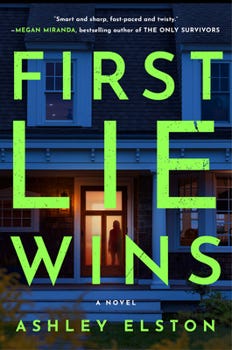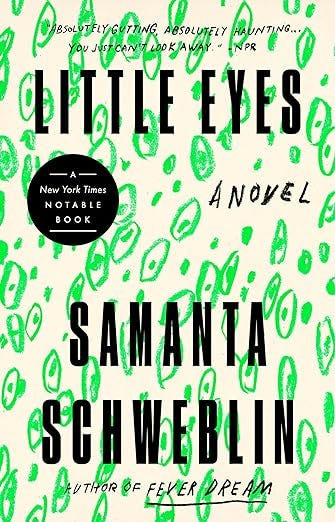I just finished reading First Lie Wins by Ashley Elston, and it’s a really fun book. This is hardly a controversial take—it’s everywhere right now, and deservedly so. But it got me thinking about endings because it has a great one: an actual twist, one I didn’t see coming.
I’m not often surprised by endings. I can guess who did it most of the time, and even if I’m not exactly right, the ending is usually something I understood to be within the realm of possibility. It’s almost always a matter of asking what kind of ending would be satisfying here along with what details were thrown into the story that only make sense if they’re building up to something? Chekhov’s gun, etc.
And it’s fine if there’s no big twist! I don’t mind guessing the ending if the rest of the story is compelling. But—and I think this is going to be generic enough that it won’t spoil the ending—First Lie Wins surprised me in the best possible way. It made me think I was looking for the answer to one question, got me really invested in looking for clues, and then pulled the rug out from under me. A sleight of hand, fitting for a novel about con artists and double-crossing. It made me say, oh, that’s what I was reading? The ending actually changed the meaning of everything that had come before—which, I think, is the Holy Grail of a thriller ending.
What IS a twist ending?
Books are often described as having a twist when something surprising happens in them. A killer is revealed, and it’s not who you were thinking: twist! But while surprise is important, there’s something more that sets true twists apart.
has a great series on endings on her Substack, and one genre of endings she identifies is the “Game Changer”: the Sixth-Sense-type ending that “destabilizes you from everything you thought the narrative was.” This is, I think, what people really mean by “twist.” It’s not just a surprise; it’s a revelation that layers a second meaning onto everything that came before. If you went back and read the book (or watched the movie) a second time, you would see something totally different, and it would still all hold together.What are the forms a twist might take?
Surprise endings tend to take two forms: (1) the surprise-villain reveal, or (2) the answer to the question you didn’t think to ask.
The surprise-villain reveal is, by far, the most common. You thought the murderer was going to be the husband, but in fact it was the grandmother. These endings are often surprising, but not always destabilizing. When they’re destabilizing, they can rise to the level of true twist.
In the answer-to-the-question-you-didn’t-think-to-ask ending, you thought the murderer was going to be the husband, but it turns out Amy staged her own disappearance and set Nick up to take the fall, so you should have been questioning whether there was even a murder in the first place. (I’ll stick with Gone Girl and other similar examples here—I assume everyone already knows these twists, so I’m not spoiling anything.) This kind of reveal is less common, more memorable, and harder to pull off. When it works, it is always destabilizing.
What makes a twist work (or not work)?
Twists work by subverting a reader’s expectations about story structure and its possibilities. This might be by playing with a reader’s preconceptions about certain types of characters, by toying with structure, or by sleight of hand.
1. Playing with Preconceptions
When a surprise-villain ending rises to the level of twist, it’s often because it upends the reader’s ideas about who the villain can be. These ideas might be rooted in beliefs about the world, in beliefs about story structure, or both. The husband is an inherently suspicious character in domestic suspense, for example, given both real-world stats and the traditional arc of the domestic-suspense story. The same isn’t true about a grandmother character, and so it’s at least surprising if she’s the killer.
This reveal can go beyond surprising if the reader really does have a blind-spot—her view of this kind of character is actually misguided or too limited—and the reveal corrects that blind-spot. In that case, the revelation of the villain not only gives new meaning to the clues that came earlier, it opens up a new interpretation of that type of character or person in the world. When viewers saw Kevin Spacey gradually losing his limp in The Usual Suspects, for example, it was actually disorienting. His character had been set up as our lens into the criminal underworld, our (Great Gatsby, not Gone Girl) Nick. Viewer conceptions were probably also shaped by the fact that he was disabled, or pretending to be. When you watch The Usual Suspects a second time, it’s a different movie.
2. Toying with structure
Twists can also emerge from the way a story is structured—for example, by introducing an unreliable medium into the narrative, or playing with time or identity.
Unreliable media. It’s common for thrillers to have sections or entire chapters written as diary entries or letters, and also common for these written instruments to turn out to be misleading in some way. We later discover the journal entries were a lie, for instance, or they have a different author than we initially believed.
In the post-Gone Girl world, these kinds of written instruments are inherently suspicious. I am on guard every time I see something purportedly written by a character, immediately questioning whether I can trust it. That’s not necessarily a problem—some of those questions are part of the fun of reading thrillers—but it does lessen the potential for disorientation.
Playing games with time or identity (or, the leaving-off-the-time-stamp method). Thrillers often jump around in time or point of view, and, in books with this kind of structure, it’s common for there to be a guidepost at the beginning of each chapter. (Something like: Sarah, New York City, Present Day.) But sometimes authors DON’T give those kinds of guideposts, and that’s often a clue they’re up to something. (E.g., you thought all those scenes in italics were in the past, but they’re really in the future! Or you thought you getting Sarah’s point of view, but it’s really her twin sister’s!)
There’s a difference between feeling surprised and feeling tricked, and these structural games can run the risk of seeming unfair. But as long as the reader doesn’t feel jerked around—for instance, if she knows there’s some mystery about whose point of view she’s inhabiting—it can be an effective method for subverting expectations.
3. Sleight of Hand
Most question-you-didn’t-think-to-ask endings involve sleight of hand. The author dangles a question for the reader to answer, and it’s a good question, with clues and red herrings, so the reader’s attention is focused elsewhere. While the reader is trying to answer this first question, the author provides the answer to a second, even bigger, question, one the reader never thought to ask. What’s going on with the boy who sees ghosts? is a good question, and it distracts from the second, bigger question: Is our protagonist even alive?
It’s important the question is something that seems fair and plausible given the rules of the world that have already been established. We KNOW there are ghosts in the Sixth Sense, so it’s fine for Bruce Willis to be one, too. We KNOW there is marital strife in Gone Girl; we were just wrong about the particular dynamics. I won’t say too much about the specifics of First Lie Wins, but we know we’re operating in a world of cons.1 We’re so intrigued by the first question the story poses that we’re distracted, and that’s why we miss the set-up to the second question. It was there the whole time, though, available for us to see if we were only looking.
Why are true twists so rare?
A true twist is a challenge to the reader: you think you understand the full range of possibilities here, but there are many more than you realize. Any time a book successfully pulls off a twist, it’s a discovery, opening us up to those new possibilities. We won’t be fooled by ghosts again, and we’ll be less naive about diary entries. But, of course, there are always new frontiers and new possibilities to explore.
Currently reading: Little Eyes by Samanta Schweblin
If you think of any types of twists or methods I’m missing, would love to hear them in the comments!
“But what if they’re really SLEEPING and it’s all a DREAM” usually feels unfair, but not if it’s Inception and you’ve been primed.





